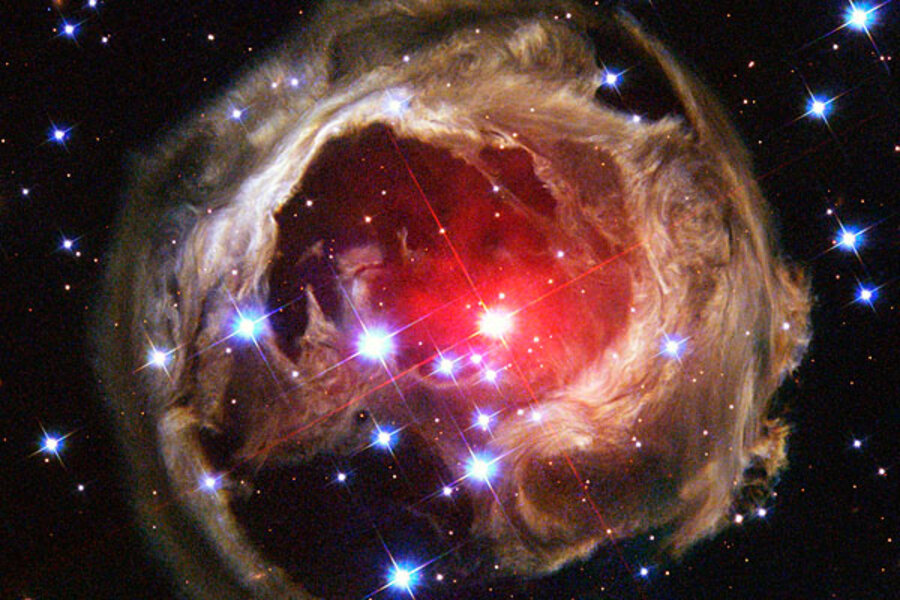As largest star in Milky Way dies, fascinated scientists look on
Loading...
The largest known star in the galaxy, parked in a star cluster some 16,000 light-years away, has exhausted its hydrogen fuel and is shedding gas in a signal that the end is near – at least on cosmic timescales.
The star, a red supergiant, is surrounded by clouds of glowing hydrogen, providing a rare opportunity to observe a massive star during such an early stage in its prolonged demise – a path slated to end with the star's catastrophic collapse and the subsequent explosion at its core, known as a supernova.
Such explosions seed the galaxy with chemical elements heavier than hydrogen and helium. These elements form in the fusion furnaces at the heart of stars. The elements get ejected into interstellar space by stellar winds as well as by events that occur at the end of a star's life. They become the raw material for building other objects in the cosmos – from planets to people.
Studying gas clouds such stars release as they lose mass can yield insights into the physical processes at work as well as clues as to the kind of compact object – a neutron star, or perhaps a black hole – the star's core could become after its explosive end.
Some of the massive stars that end their runs as core-collapse supernovae "have lost a lot of mass close to their end," writes Jeremy Drake, an astrophysicist at the Harvard-Smithsonian Center for Astrophysics in Cambridge, Mass., and a member of the research team reporting the results.
"It would be very interesting to catch one in such a mass-loss phase," he writes in an e-mail. At the same time, he adds, estimated of such losses are very uncertain and can have a profound effect on the future course of the star's evolution.
Studying stars like W26 and its nebula can help refine those estimates, he notes.
But detecting the clouds of hot, glowing gas around such massive stars is rare, the researchers say, adding that no one has observed such gas clouds around a red supergiant before.
The doomed star appears in Westerlund 1, a cluster of newly forming stars with a combined mass of about 50,000 suns. This makes it the most massive star-forming cluster in the Milky Way. Labeled W26, the star is 1,500 times larger than the sun. Side by side, W26 would be a 10-foot balloon to the sun's flea.
Janet Drew, with the University of Hertfordshire's Centre for Astrophysical Research in Britain, first noticed W26's nebula during a survey she was conducting of Westerlund 1. It popped out last year as she was running quality-control checks on the survey's data, recalls Nicholas Wright, a colleague at the university and the lead author of the paper reporting the results. The paper is set for publication in an upcoming issue of the Monthly Notices of the Royal Astronomical Society in Britain.
"I was very excited" when Dr. Drew sent an e-mail describing the find, Dr. Wright recalls. He had studied similar gas clouds around a blue supergiant star, Sher 25, earlier in his career. Blue supergiants tend to be less massive that red supergiants. They can can have a more complicated path toward demise with a wider range of outcomes than their larger, redder cousins.
Previous observations of this cluster at radio and submillimeter wavelengths hinted at the presence of W26 and its glowing nebula. But by their nature, observations at those wavelengths don't yield good measurements of the pace at which the gas is traveling and the mix of elements in it, Wright explains.
Drew's survey was conducted at visible wavelengths using the VLT Survey Telescope at the European Southern Observatory's Paranal Observatory in Chile's Atacama Desert.
The star's location helped make the discovery possible, the researchers say. One reason no one has seen the gas outflow from a red supergiant before is that they are so comparatively cool, they fail to provide enough energy to ionize the gas and set it glowing.
The source of energy lighting W26's nebula is unclear, but the team says it suspects radiation levels in the cluster as a whole, a hot house of star formation, could be the energy source. The other possibility is a hot companion star nearby, but no such star appears in the data.








